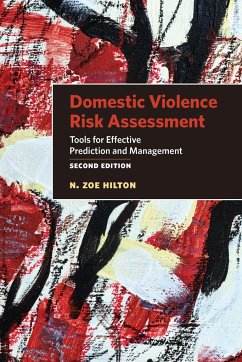- Broschiertes Buch
- Merkliste
- Auf die Merkliste
- Bewerten Bewerten
- Teilen
- Produkt teilen
- Produkterinnerung
- Produkterinnerung
Revised edition of Risk assessment for domestically violent men, c2010.
Andere Kunden interessierten sich auch für
![Understanding Sexual Harassment Understanding Sexual Harassment]() William E FooteUnderstanding Sexual Harassment54,99 €
William E FooteUnderstanding Sexual Harassment54,99 €![Law and Mental Health Professionals: California Law and Mental Health Professionals: California]() O Brant CaudillLaw and Mental Health Professionals: California30,99 €
O Brant CaudillLaw and Mental Health Professionals: California30,99 €![Lies People Tell Lies People Tell]() Frank RunlesLies People Tell10,99 €
Frank RunlesLies People Tell10,99 €![On the Witness Stand: Essays on Psychology and Crime On the Witness Stand: Essays on Psychology and Crime]() Hugo MunsterbergOn the Witness Stand: Essays on Psychology and Crime15,99 €
Hugo MunsterbergOn the Witness Stand: Essays on Psychology and Crime15,99 €![Supporting Legal Capacity in Socio-Legal Context Supporting Legal Capacity in Socio-Legal Context]() Supporting Legal Capacity in Socio-Legal Context63,99 €
Supporting Legal Capacity in Socio-Legal Context63,99 €![Completely Fragmented Completely Fragmented]() Nigel PearceCompletely Fragmented27,99 €
Nigel PearceCompletely Fragmented27,99 €![Representing People with Autism Spectrum Disorders Representing People with Autism Spectrum Disorders]() Elizabeth KelleyRepresenting People with Autism Spectrum Disorders59,99 €
Elizabeth KelleyRepresenting People with Autism Spectrum Disorders59,99 €-
-
-
Produktdetails
- Produktdetails
- Verlag: American Psychological Association (APA)
- 2nd edition
- Seitenzahl: 349
- Erscheinungstermin: 29. Dezember 2020
- Englisch
- Abmessung: 227mm x 151mm x 19mm
- Gewicht: 502g
- ISBN-13: 9781433832918
- ISBN-10: 1433832917
- Artikelnr.: 59077609
- Herstellerkennzeichnung
- Libri GmbH
- Europaallee 1
- 36244 Bad Hersfeld
- gpsr@libri.de
- Verlag: American Psychological Association (APA)
- 2nd edition
- Seitenzahl: 349
- Erscheinungstermin: 29. Dezember 2020
- Englisch
- Abmessung: 227mm x 151mm x 19mm
- Gewicht: 502g
- ISBN-13: 9781433832918
- ISBN-10: 1433832917
- Artikelnr.: 59077609
- Herstellerkennzeichnung
- Libri GmbH
- Europaallee 1
- 36244 Bad Hersfeld
- gpsr@libri.de
N. Zoe Hilton, PhD, is associate professor of psychiatry at the University of Toronto and Senior Research Scientist at the Waypoint Centre for Mental Health Care in Penetanguishene, Ontario. She is also a registered psychologist and a Fellow of the Canadian Psychological Association. She has authored or coauthored over publications, primarily on violence risk assessment, risk communication, and other areas of forensic psychology. She received the 2 Significant Contribution Award from the Canadian Psychological Association Criminal Justice Section for outstanding contributions to domestic violence risk assessment. Zoe Hilton lives and works in Ontario, Canada.
Acknowledgments
Introduction: Domestic Violence Assessment and Risk Management
Part I. Overview of Domestic Violence Risk Assessment
Chapter 1. Domestic Violence Risk Assessment Research and Theory
Chapter 2: Risk Assessment for Criminal Justice, Domestic Violence
Treatment, and Victim Services
Part II: Understanding and Applying the ODARA and the DVRAG
Chapter 3: Creating a Frontline Risk Assessment: The Ontario Domestic
Assault Risk Assessment (ODARA)
Chapter 4: Validations and Applications of the Ontario Domestic Assault
Risk Assessment (ODARA)
Chapter 5: Creating an In-depth Risk Assessment: The Domestic Violence Risk
Appraisal Guide (DVRAG)
Chapter 6: Scoring Manual for the Ontario Domestic Assault Risk Assessment
(ODARA)
Chapter 7: Scoring Manual for the Domestic Violence Risk Appraisal Guide
(DVRAG)
Part III: Additional Considerations for Risk Assessment and Management
Chapter 8: Choosing a Risk Assessment Approach: Hypothesis Versus Evidence
Chapter 9: Risk Communication
Chapter 10: Implementing Actuarial Risk Assessment
Chapter 11: Questions and Answers about the Ontario Domestic Assault Risk
Assessment / Domestic Violence Risk Appraisal Guide (ODARA/DVRAG) System
Afterword: Future Directions in Domestic Abuse Assessment and Risk
Management
Appendix: Case Materials for Scoring Practice
References
Index
About the Author
Introduction: Domestic Violence Assessment and Risk Management
Part I. Overview of Domestic Violence Risk Assessment
Chapter 1. Domestic Violence Risk Assessment Research and Theory
Chapter 2: Risk Assessment for Criminal Justice, Domestic Violence
Treatment, and Victim Services
Part II: Understanding and Applying the ODARA and the DVRAG
Chapter 3: Creating a Frontline Risk Assessment: The Ontario Domestic
Assault Risk Assessment (ODARA)
Chapter 4: Validations and Applications of the Ontario Domestic Assault
Risk Assessment (ODARA)
Chapter 5: Creating an In-depth Risk Assessment: The Domestic Violence Risk
Appraisal Guide (DVRAG)
Chapter 6: Scoring Manual for the Ontario Domestic Assault Risk Assessment
(ODARA)
Chapter 7: Scoring Manual for the Domestic Violence Risk Appraisal Guide
(DVRAG)
Part III: Additional Considerations for Risk Assessment and Management
Chapter 8: Choosing a Risk Assessment Approach: Hypothesis Versus Evidence
Chapter 9: Risk Communication
Chapter 10: Implementing Actuarial Risk Assessment
Chapter 11: Questions and Answers about the Ontario Domestic Assault Risk
Assessment / Domestic Violence Risk Appraisal Guide (ODARA/DVRAG) System
Afterword: Future Directions in Domestic Abuse Assessment and Risk
Management
Appendix: Case Materials for Scoring Practice
References
Index
About the Author
Acknowledgments
Introduction: Domestic Violence Assessment and Risk Management
Part I. Overview of Domestic Violence Risk Assessment
Chapter 1. Domestic Violence Risk Assessment Research and Theory
Chapter 2: Risk Assessment for Criminal Justice, Domestic Violence
Treatment, and Victim Services
Part II: Understanding and Applying the ODARA and the DVRAG
Chapter 3: Creating a Frontline Risk Assessment: The Ontario Domestic
Assault Risk Assessment (ODARA)
Chapter 4: Validations and Applications of the Ontario Domestic Assault
Risk Assessment (ODARA)
Chapter 5: Creating an In-depth Risk Assessment: The Domestic Violence Risk
Appraisal Guide (DVRAG)
Chapter 6: Scoring Manual for the Ontario Domestic Assault Risk Assessment
(ODARA)
Chapter 7: Scoring Manual for the Domestic Violence Risk Appraisal Guide
(DVRAG)
Part III: Additional Considerations for Risk Assessment and Management
Chapter 8: Choosing a Risk Assessment Approach: Hypothesis Versus Evidence
Chapter 9: Risk Communication
Chapter 10: Implementing Actuarial Risk Assessment
Chapter 11: Questions and Answers about the Ontario Domestic Assault Risk
Assessment / Domestic Violence Risk Appraisal Guide (ODARA/DVRAG) System
Afterword: Future Directions in Domestic Abuse Assessment and Risk
Management
Appendix: Case Materials for Scoring Practice
References
Index
About the Author
Introduction: Domestic Violence Assessment and Risk Management
Part I. Overview of Domestic Violence Risk Assessment
Chapter 1. Domestic Violence Risk Assessment Research and Theory
Chapter 2: Risk Assessment for Criminal Justice, Domestic Violence
Treatment, and Victim Services
Part II: Understanding and Applying the ODARA and the DVRAG
Chapter 3: Creating a Frontline Risk Assessment: The Ontario Domestic
Assault Risk Assessment (ODARA)
Chapter 4: Validations and Applications of the Ontario Domestic Assault
Risk Assessment (ODARA)
Chapter 5: Creating an In-depth Risk Assessment: The Domestic Violence Risk
Appraisal Guide (DVRAG)
Chapter 6: Scoring Manual for the Ontario Domestic Assault Risk Assessment
(ODARA)
Chapter 7: Scoring Manual for the Domestic Violence Risk Appraisal Guide
(DVRAG)
Part III: Additional Considerations for Risk Assessment and Management
Chapter 8: Choosing a Risk Assessment Approach: Hypothesis Versus Evidence
Chapter 9: Risk Communication
Chapter 10: Implementing Actuarial Risk Assessment
Chapter 11: Questions and Answers about the Ontario Domestic Assault Risk
Assessment / Domestic Violence Risk Appraisal Guide (ODARA/DVRAG) System
Afterword: Future Directions in Domestic Abuse Assessment and Risk
Management
Appendix: Case Materials for Scoring Practice
References
Index
About the Author








